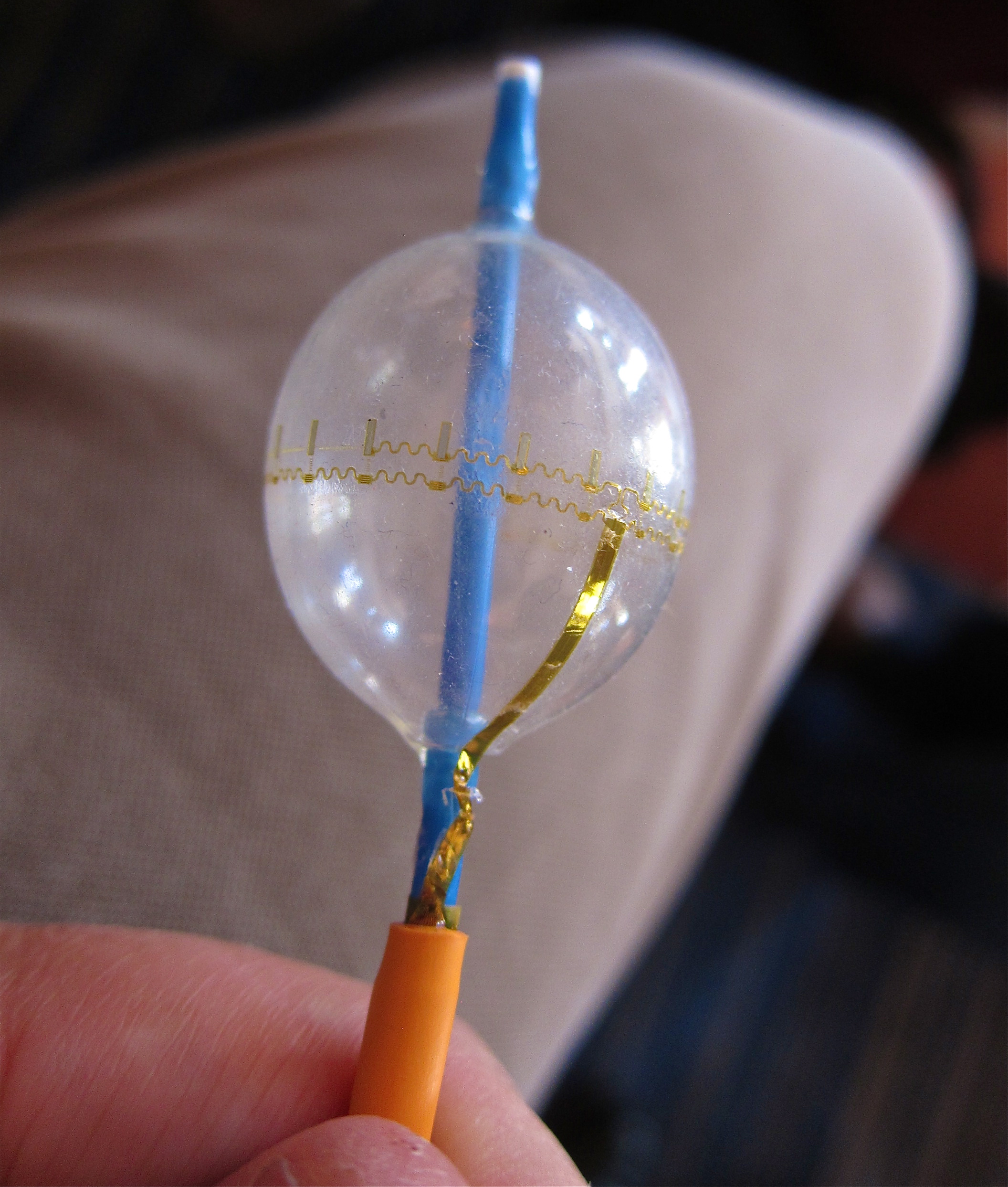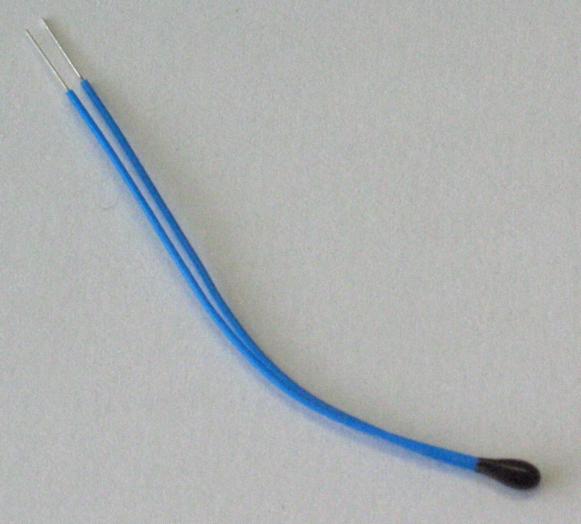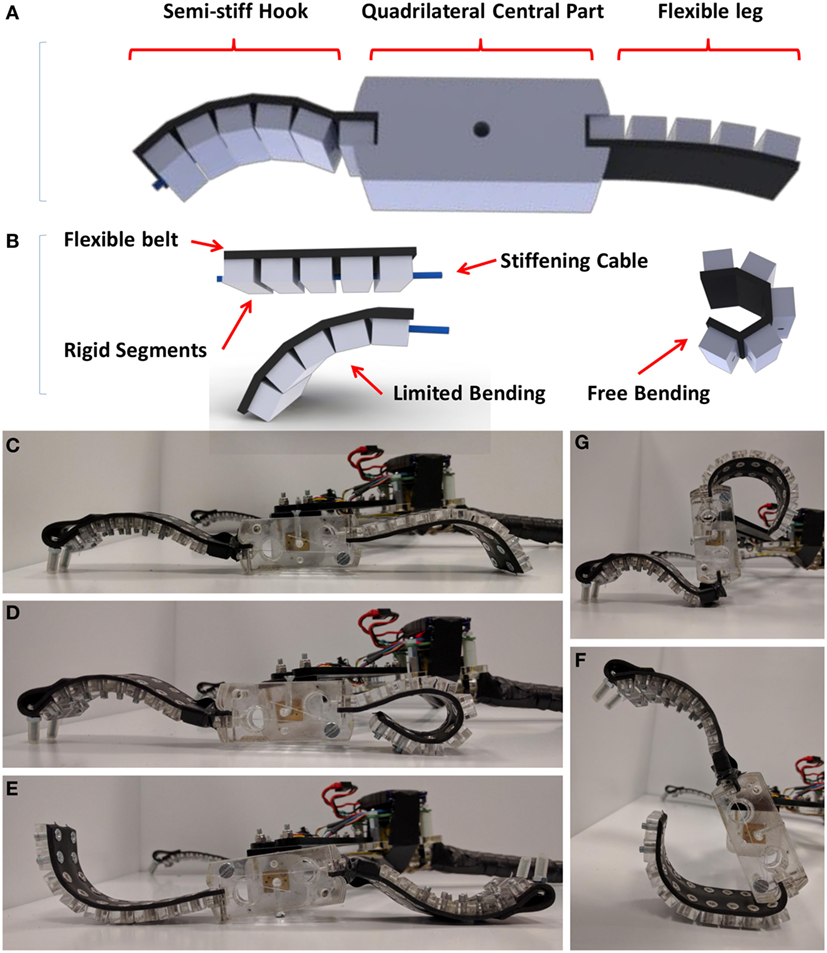|
Stretch Sensor
A stretch sensor is a sensor which can be used to measure deformation and stretching forces such as tension or bending. They are usually made from a material that is itself soft and stretchable. Most stretch sensors fall into one of three categories. The first type consists of an electrical conductor for which the electrical resistance changes (usually increases) substantially when the sensor is deformed. The second type consists of a capacitor for which the capacitance changes under deformation. Known properties of the sensor can then be used to deduce the deformation from the resistance/capacitance. Both the rheostatic and capacitive types often take the form of a cord, tape, or mesh. The third type of sensor uses high performance piezoelectric systems in soft, flexible/stretchable formats for measuring signals using the capability of piezoelectric materials to interconvert mechanical and electrical forms of energy. Applications Wearable stretch sensors can be used for tas ... [...More Info...] [...Related Items...] OR: [Wikipedia] [Google] [Baidu] |
Sensor
A sensor is a device that produces an output signal for the purpose of sensing a physical phenomenon. In the broadest definition, a sensor is a device, module, machine, or subsystem that detects events or changes in its environment and sends the information to other electronics, frequently a computer processor. Sensors are always used with other electronics. Sensors are used in everyday objects such as touch-sensitive elevator buttons ( tactile sensor) and lamps which dim or brighten by touching the base, and in innumerable applications of which most people are never aware. With advances in micromachinery and easy-to-use microcontroller platforms, the uses of sensors have expanded beyond the traditional fields of temperature, pressure and flow measurement, for example into MARG sensors. Analog sensors such as potentiometers and force-sensing resistors are still widely used. Their applications include manufacturing and machinery, airplanes and aerospace, cars, medicine, ... [...More Info...] [...Related Items...] OR: [Wikipedia] [Google] [Baidu] |
Robotics
Robotics is an interdisciplinary branch of computer science and engineering. Robotics involves design, construction, operation, and use of robots. The goal of robotics is to design machines that can help and assist humans. Robotics integrates fields of mechanical engineering, electrical engineering, information engineering, mechatronics, electronics, bioengineering, computer engineering, control engineering, software engineering, mathematics, etc. Robotics develops machines that can substitute for humans and replicate human actions. Robots can be used in many situations for many purposes, but today many are used in dangerous environments (including inspection of radioactive materials, bomb detection and deactivation), manufacturing processes, or where humans cannot survive (e.g. in space, underwater, in high heat, and clean up and containment of hazardous materials and radiation). Robots can take any form, but some are made to resemble humans in appearance. This is claimed t ... [...More Info...] [...Related Items...] OR: [Wikipedia] [Google] [Baidu] |
Resistive Components
The electrical resistance of an object is a measure of its opposition to the flow of electric current. Its reciprocal quantity is , measuring the ease with which an electric current passes. Electrical resistance shares some conceptual parallels with mechanical friction. The SI unit of electrical resistance is the ohm (), while electrical conductance is measured in siemens (S) (formerly called the 'mho' and then represented by ). The resistance of an object depends in large part on the material it is made of. Objects made of electrical insulators like rubber tend to have very high resistance and low conductance, while objects made of electrical conductors like metals tend to have very low resistance and high conductance. This relationship is quantified by resistivity or conductivity. The nature of a material is not the only factor in resistance and conductance, however; it also depends on the size and shape of an object because these properties are extensive rather than inte ... [...More Info...] [...Related Items...] OR: [Wikipedia] [Google] [Baidu] |
Sensors
A sensor is a device that produces an output signal for the purpose of sensing a physical phenomenon. In the broadest definition, a sensor is a device, module, machine, or subsystem that detects events or changes in its environment and sends the information to other electronics, frequently a computer processor. Sensors are always used with other electronics. Sensors are used in everyday objects such as touch-sensitive elevator buttons ( tactile sensor) and lamps which dim or brighten by touching the base, and in innumerable applications of which most people are never aware. With advances in micromachinery and easy-to-use microcontroller platforms, the uses of sensors have expanded beyond the traditional fields of temperature, pressure and flow measurement, for example into MARG sensors. Analog sensors such as potentiometers and force-sensing resistors are still widely used. Their applications include manufacturing and machinery, airplanes and aerospace, cars, medicine, ro ... [...More Info...] [...Related Items...] OR: [Wikipedia] [Google] [Baidu] |
Stretch Receptor
Stretch receptors are mechanoreceptors responsive to distention of various organs and muscles, and are neurologically linked to the Medulla oblongata, medulla in the brain stem via Afferent nerve fiber, afferent nerve fibers. Examples include stretch receptors in the arm and leg muscles and tendons, in the heart, in the colon wall, and in the lungs. Stretch receptors are also found around the carotid artery, where they monitor blood pressure and stimulate the release of antidiuretic hormone (vasopressin, ADH) from the posterior pituitary gland. Types include: * Golgi organ * Muscle spindle, sensory receptors within the belly of a muscle, which primarily detect changes in the length of this muscle * Pulmonary stretch receptors, mechanoreceptors found in the lungs * Chordotonal organ, in insects See also * Stretch sensor References {{biology-stub Sensory receptors ... [...More Info...] [...Related Items...] OR: [Wikipedia] [Google] [Baidu] |
Stretchable Electronics
Stretchable electronics, also known as elastic electronics or elastic circuits, is a group of technologies for building electronic circuits by depositing or embedding electronic devices and circuits onto stretchable substrates such as silicones or polyurethanes, to make a completed circuit that can experience large strains without failure. In the simplest case, stretchable electronics can be made by using the same components used for rigid printed circuit boards, with the rigid substrate cut (typically in a serpentine pattern) to enable in-plane stretchability. However, many researchers have also sought intrinsically stretchable conductors, such as liquid metals. One of the major challenges in this domain is designing the substrate and the interconnections to be stretchable, rather than flexible (see Flexible electronics) or rigid (Printed Circuit Boards). Typically, polymers are chosen as substrates or material to embed. When bending the substrate, the outermost radius of th ... [...More Info...] [...Related Items...] OR: [Wikipedia] [Google] [Baidu] |
Thermistor
A thermistor is a type of resistor whose resistance is strongly dependent on temperature, more so than in standard resistors. The word thermistor is a portmanteau of ''thermal'' and ''resistor''. Thermistors are divided based on their conduction model. Negative Temperature Coefficient (NTC) thermistors have ''less'' resistance at ''higher'' temperatures, while Positive Temperature Coefficient (PTC) thermistors have ''more'' resistance at ''higher'' temperatures. Hence, a PTC thermistor's resistance is directly proportional to temperature. NTC thermistor are widely used as inrush current limiters, temperature sensors, while PTC thermistors are used as self-resetting overcurrent protectors, and self-regulating heating elements. An operational temperature range of a thermistor is dependent on the probe type and is typically between −100 °C and 300 °C (−148 °F and 572 °F). Types Depending on materials used, thermistors are classified into two types: *With ''NTC'' th ... [...More Info...] [...Related Items...] OR: [Wikipedia] [Google] [Baidu] |
Force Gauge
A force gauge (also called a force meter) is a measuring instrument used to measure forces. Applications exist in research and development, laboratory, quality, production and field environment. There are two kinds of force gauges today: mechanical and digital force gauges. Force Gauges usually measure pressure in Objective stress rate, stress increments and other dependent human factors. Mechanical force gauges A common mechanical force scale, known as the spring scale, features a hook and a spring that attach to an object and measure the amount of force exerted on the spring in order to extend it. Electrical gauge An example of an electrical force gauge is an "electronic scale". One or more electrical load cells (commonly referred to as "weigh bars") are used to support a vertical or horizontal "live load" and are solid-state potentiometers which have variable internal resistance proportional to the load they are subjected to and deflected by. As the load and deflection increase ... [...More Info...] [...Related Items...] OR: [Wikipedia] [Google] [Baidu] |
Flexible Electronics
Flexible electronics, also known as ''flex circuits'', is a technology for assembling electronic circuits by mounting electronic devices on flexible plastic substrates, such as polyimide, PEEK or transparent conductive polyester film. Additionally, flex circuits can be screen printed silver circuits on polyester. Flexible electronic assemblies may be manufactured using identical components used for rigid printed circuit boards, allowing the board to conform to a desired shape, or to flex during its use. Manufacturing Flexible printed circuits (FPC) are made with a photolithographic technology. An alternative way of making flexible foil circuits or flexible flat cables (FFCs) is laminating very thin (0.07 mm) copper strips in between two layers of PET. These PET layers, typically 0.05 mm thick, are coated with an adhesive which is thermosetting, and will be activated during the lamination process. FPCs and FFCs have several advantages in many applications: * Tightl ... [...More Info...] [...Related Items...] OR: [Wikipedia] [Google] [Baidu] |
Soft Robots
Soft robotics is a subfield of robotics that concerns the design, control, and fabrication of robots composed of compliant materials, instead of rigid links. In contrast to rigid-bodied robots built from metals, ceramics and hard plastics, the compliance of soft robots can improve their safety when working in close contact with humans. Types and designs The goal of soft robotics is the design and construction of robots with physically flexible-bodies and electronics. Sometimes softness is limited to part of the machine. For example, rigid-bodied robotic arms can employ soft end effectors to gently grab and manipulate delicate or irregularly shaped objects. Most rigid-bodied mobile robots also strategically employ soft components, such as foot pads to absorb shock or springy joints to store/release elastic energy. However, the field of soft robotics generally leans toward machines that are predominately or entirely soft. Robots with entirely soft bodies have tremendous potenti ... [...More Info...] [...Related Items...] OR: [Wikipedia] [Google] [Baidu] |
Data Glove
A wired glove (also called a dataglove or cyberglove) is an input device for human–computer interaction worn like a glove. Various sensor technologies are used to capture physical data such as bending of fingers. Often a motion tracker, such as a magnetic tracking device or inertial tracking device, is attached to capture the global position/rotation data of the glove. These movements are then interpreted by the software that accompanies the glove, so any one movement can mean any number of things. Gestures can then be categorized into useful information, such as to recognize sign language or other symbolic functions. Expensive high-end wired gloves can also provide haptic feedback, which is a simulation of the sense of touch. This allows a wired glove to also be used as an output device. Traditionally, wired gloves have only been available at a huge cost, with the finger bend sensors and the tracking device having to be bought separately. Wired gloves are often used in ... [...More Info...] [...Related Items...] OR: [Wikipedia] [Google] [Baidu] |
Deformation (engineering)
In engineering, deformation refers to the change in size or shape of an object. ''Displacements'' are the ''absolute'' change in position of a point on the object. Deflection is the relative change in external displacements on an object. Strain is the ''relative'' internal change in shape of an infinitesimally small cube of material and can be expressed as a non-dimensional change in length or angle of distortion of the cube. Strains are related to the forces acting on the cube, which are known as stress, by a stress-strain curve. The relationship between stress and strain is generally linear and reversible up until the yield point and the deformation is elastic. The linear relationship for a material is known as Young's modulus. Above the yield point, some degree of permanent distortion remains after unloading and is termed plastic deformation. The determination of the stress and strain throughout a solid object is given by the field of strength of materials and for a structu ... [...More Info...] [...Related Items...] OR: [Wikipedia] [Google] [Baidu] |







